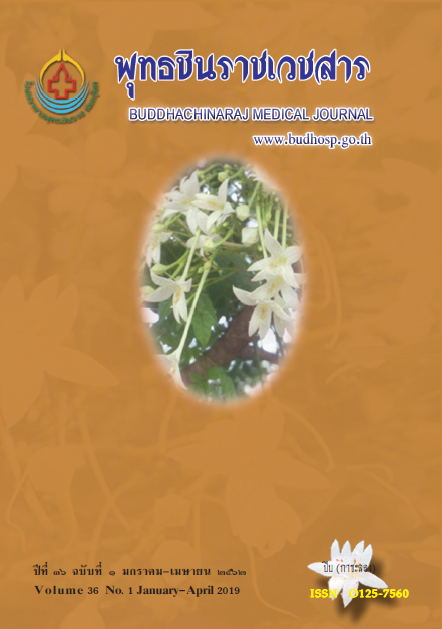ปัจจัยทำนายของการพบร่องรอยบาดเจ็บที่ศีรษะในภาพถ่ายเอกซเรย์คอมพิวเตอร์ สมองในผู้ป่วยบาดเจ็บศีรษะระดับเล็กน้อย
คำสำคัญ:
ผู้ป่วยบาดเจ็บศีรษะระดับเล็กน้อย, การเอกซเรย์คอมพิวเตอร์สมองบทคัดย่อ
ส่วนใหญ่ของผู้ป่วยที่มีอาการบาดเจ็บที่ศีรษะเป็นผู้ป่วยได้รับบาดเจ็บศีรษะระดับเล็กน้อย การทราบปัจจัย ทำนายทำให้สามารถคัดเลือกผู้ป่วยที่ได้รับบาดเจ็บศีรษะระดับเล็กน้อยให้ได้รับการส่งตรวจเอกซเรย์คอมพิวเตอร์ สมองเพื่อวินิจฉัยร่องรอยบาดเจ็บที่ศีรษะในภาพถ่ายเอกซเรย์คอมพิวเตอร์สมองและหาผู้ป่วยกลุ่มที่จำเป็นต้อง ได้รับการผ่าตัดโดยการศึกษาแบบวิเคราะห์ข้อมูลย้อนหลัง จากเวชระเบียนผู้ป่วยบาดเจ็บศีรษะระดับเล็กน้อย ระดับความรู้สึกตัวตั้งแต่ 13-15 คะแนนที่มีอายุตั้งแต่ 16 ปีขึ้นไป กลุ่มตัวอย่างเป็นผู้ป่วยบาดเจ็บศีรษะระดับ เล็กน้อยจำนวน 1233 รายที่เข้ารับการรักษาตัวในโรงพยาบาลหาดใหญ่ ตั้งแต่เดือนตุลาคม 2559-ตุลาคม 2560 สถิติที่ใช้ ค่าความถี่และร้อยละความสัมพันธ์ทางสถิติโดยใช้ Fisher, s Exact Test X2 Test และ Binary regression ผลการวิจัยพบว่าความผิดปกติในเอกซเรย์คอมพิวเตอร์สมองจำนวน 353 คน (ร้อยละ28.6) ไม่พบความผิดปกติ จำนวน 880 คน (ร้อยละ71.4) พบว่ามี 8 ปัจจัยที่มีความสัมพันธ์กับการพบความผิดปกติในเอกซเรย์คอมพิวเตอร์ สมองอย่างมีนัยทางสถิติที่ 0.05 และเมื่อนำมาวิเคราะห์พหุตัวแปรพบความสามารถในการทำนายความเสี่ยงของ การตรวจพบร่องรอยบาดเจ็บที่สมองของผู้ป่วยบาดเจ็บศีรษะชนิดไม่รุนแรงอย่างมีนัยสำคัญทางสถิติ มี 7 ปัจจัย คือเพศชาย ปวดศีรษะ อาเจียนมากกว่าหรือเท่ากับ 2 ครั้ง ระดับความรู้สึกตัวที่ 13-14 คะแนน ผู้ป่วยที่สงสัย กะโหลกแตก ผู้ป่วยที่มีกะโหลกฐานศีรษะแตก ผู้ป่วยที่มีกลไกได้รับอุบัติเหตุรุนแรงโดยเฉพาะขับขี่มอเตอร์ไซด์ ปราศจากสวมหมวกนิรภัย
เอกสารอ้างอิง
2. สวิง ปันจัยสีห์, นครชัย เผื่อนปฐม, กุลพัฒน์ วีรสาร, บรรณาธิการ. แนวทางเวชปฏิบัติกรณีสมองบาดเจ็บ: Clinical Practice Guidelines for Traumatic Brain Injury. 2013. [cited 2018 Mar 17].Available from:URl: http://pni.go.th/pnigoth/wp-content/uploads//2013/10/Clinical-Practice-Guidelines-for-Traumatic-Brain-Injury.pdf
3. Af Geijerstam JL , Britton M . Mild head injury: mortality and complication ratemeta-analysis of findings in a systematic literature review. Acta Neurochir (Wien) 2003;145:843-50.
4. Haydel MJ, Preston CA, Mills TJ, Luber S, Blaudeau E, DeBlieux PM. Indications for computed tomography in patients with minor head injury. N Engl J Med 2000;343(2):100-5.
5. Stiell IG, Wells GA, Vandemheen K, Clement C, Lesiuk H, Laupacis A, et al. The Canadian CT Head Rule for patients with minor head injury. Lancet 2001;357:1391-6.
6. Af Geijerstam JL, Britton M, Marke LA. Mild head injury:observation or computed tomography? economic aspects by literaturereview and decision analysis. Emerg Med J 2004;21:54-8.
7. Af Geijerstam JL, Oredsson S, Britton M. Medical outcome after immediate computed tomography or admission for observation in patients with mild head injury:randomised controlled trial. BMJ 2006; 333:465.
8. Norlund A, Marke LA, Af Geijerstam JL, Oredsson S, Britton M. Immediate computed tomography or admission for observation after mild head injury: cost comparison in randomised controlled trial. BMJ 2006;333:469-72.
9. Yuksen C, Trainarongsakul T. Can Mild Traumatic Brain Injury risk score (MTBI risk score) predict for positive CT brain result in high risk of mild head injury patients?. Rama Med J 2013;36: 89-101.
10. Miller EC, Derlet RW, Kinser D. Minor head trauma: Is computed tomography always necessary? Ann Emerg Med 1996;27(3):290-4.
11. Smits M, Dippel DW, Steyerberg EW, de Haan GG, Dekker HM, Vos PE, et al. Predicting intracranial traumatic findings on computed tomography in patients with minor head injury: the CHIP prediction rule. Ann Intern Med 2007;146(6):397-405.
12. Stein SC, Ross SE. The value of computed tomographic scans in patients with lowrisk head injuries. Neurosurgery 1990; 26(4):638-40.
13. Miller EC, Holmes JF, Derlet RW. Utilizing clinical factors to reduce head CT scan ordering for minor head trauma patients. J Emerg Med 1997;15(4):453-7.
14. Riccardi A, Frumento F, Guiddo G, Spinola MB, Corti L, Minuto P, et al. Minor head injury in the elderly at very low risk:a retrospective study of 6 years in an Emergency Department (ED). Am J Emerg Med 2013;31(1):37-41.






